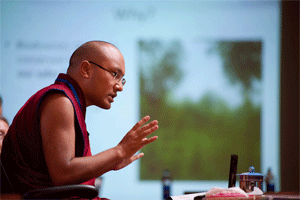5th – 9th June -Norbulingka Institute, Dharamsala
 First Hand Account
First Hand Account
Given the focus of this year’s conference, it seemed appropriate that, as the delegates gathered in the grounds of the Norbulingka Institute to await the arrival of His Holiness the 17th Gyalwang Karmapa, the temperature was climbing steadily to 42 degrees. This year, Dharamsala has experienced both unusually severe winter conditions, with snow filling the Kangra Valley for the first time in fifty years, and unusually high summer temperatures. It is a reminder to everyone present that we are now living with climate change impacts.
Celebrating World Environment Day, His Holiness the 17th Karmapa and the Honorable Speaker of the Tibetan Parliament launched the 4th Khoryug Conference on Environmental Protection for Tibetan Buddhist Monasteries, which will focus on Biodiversity, Climate Change and Natural Disaster Preparedness.
The aims of the conference are to both educate monks and nuns in environmental science, and to develop self-reliance within Buddhist institutions, so that in the face of climate change and natural disasters they have a pre-prepared plan and are able to function as leaders within the community.
After prayers for the auspiciousness of the gathering, the Gyalwang Karmapa opened the conference by saying “Preserving the biodiversity and the ecosystems of our region should be like the effortless practice of dharma for us. Our basic motivation to protect the environment should come from the pure desire to benefit all sentient beings on earth since without the environment, there can be no life.” The delegates from over 45 different monastic institutions listened intently to His Holiness’ speech and to the guest of honor, Mr Penpa Tsering, Speaker of the Tibetan Assembly.
The conference facilitator, Dekila Chungyalpa, director of the WWF Sacred Earth Program, based in Washington DC, gave the first presentation, illustrated by slides, on the concepts of biodiversity, ecosystem, ecosystem services and tipping point. Taking them one by one, she explained what they were, their importance, and how they are inter-related and how we are affected. One of the workshop goals is to demonstrate how to see nature as whole systems, she said, paralleling the holistic approach which is fundamental to Buddhist philosophy. Finally, she presented an overview and update of threats to biodiversity and the impact of climate change, two topics which will be dealt with in greater detail over the coming days.
The afternoon session was devoted to feedback from the various monastic institutions present, detailing what they had been doing in the past year to further environmental protection. This is an important function of Khoryug conferences since it provides a monitoring and evaluation framework for the projects that the monasteries undertake. Projects range from the truly impressive including thousands native trees planted in degraded watersheds to the humble where many monasteries put aside a day in the month to clean their community and town areas. Some representatives share the difficulties that they face including the disinterest among their community members in keeping their environment clean and hygienic, and or mixed reforestation results. Others share their unique experiences in achieving success and finding out that their organic farms have made them close to completely self-sufficient for fresh produce.


